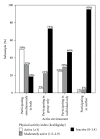Mood Disorders among Older Adults Participating in Individual and Group Active Environments: "Me" versus "Us," or Both?
- PMID: 22852085
- PMCID: PMC3407632
- DOI: 10.1155/2012/727983
Mood Disorders among Older Adults Participating in Individual and Group Active Environments: "Me" versus "Us," or Both?
Abstract
Involvement in physical activity is associated with improved mental health including better social skills, coping mechanisms, and lower rates of depression. However, evidence on whether group or individual active environments better facilitate these benefits remains inconsistent. This cross-sectional cohort study examined the mental health reports of older adults (aged 50+) in relation to participation in group or individual active environments. Logistic multivariate regression analyses were conducted on the Canadian Community Health Survey (cycle 4.1, 2007-2008, n = 44, 057). Results illustrated that those active in both group and individual environments were 59% less likely to have a mood disorder than those who were not participating in either (P < 0.001). Also, those active in both environments were 31% less likely to have a mood disorder than those active in an individual environment (P < 0.001). Participating in only group or only individual environments had a similar effect compared to individuals not active in any environments for reducing rates of reported mood disorders (22% and 28%, resp.). However, the findings related to only group environments were not significant. These findings reveal that participating in both group and individual physical activities may have important implications for maintaining older adults' mental health status.
Figures
Similar articles
-
Enrichment Effects on Adult Cognitive Development: Can the Functional Capacity of Older Adults Be Preserved and Enhanced?Psychol Sci Public Interest. 2008 Oct;9(1):1-65. doi: 10.1111/j.1539-6053.2009.01034.x. Epub 2008 Oct 1. Psychol Sci Public Interest. 2008. PMID: 26162004
-
Leisure and religious activity participation and mental health: gender analysis of older adults in Nepal.BMC Public Health. 2007 Oct 22;7:299. doi: 10.1186/1471-2458-7-299. BMC Public Health. 2007. PMID: 17953749 Free PMC article.
-
The Association of Active Living Environments and Mental Health: A Canadian Epidemiological Analysis.Int J Environ Res Public Health. 2020 Mar 15;17(6):1910. doi: 10.3390/ijerph17061910. Int J Environ Res Public Health. 2020. PMID: 32183467 Free PMC article.
-
Mental Health Professional Consultations and the Prevalence of Mood and Anxiety Disorders Among Immigrants: Multilevel Analysis of the Canadian Community Health Survey.JMIR Ment Health. 2020 Sep 16;7(9):e19168. doi: 10.2196/19168. JMIR Ment Health. 2020. PMID: 32801115 Free PMC article.
-
Systematic reviews of the effectiveness of day care for people with severe mental disorders: (1) acute day hospital versus admission; (2) vocational rehabilitation; (3) day hospital versus outpatient care.Health Technol Assess. 2001;5(21):1-75. doi: 10.3310/hta5210. Health Technol Assess. 2001. PMID: 11532238 Review.
References
-
- Statistics Canada. Population projections for Canada, provinces and territories, 2005–2031. (Catalogue No. 91-520-XIE), http://www.statcan.gc.ca/pub/91-003-x/2007001/4129904-eng.htm, 2005.
-
- United Nations. World Population Ageing: 1950–2050. New York, NY, USA: Department of Economic and Social Affairs Population Division; 2002.
-
- Statistics Canada. Canadian Community Health Survey (CCHS) Ottawa Canada: Statistics Canada; 2008.
-
- Hellström Y, Hallberg IR. Perspectives of elderly people receiving home help on health, care and quality of life. Health and Social Care in the Community. 2001;9(2):61–71. - PubMed
-
- Rowe JW, Kahn RL. Human aging: usual and successful. Science. 1987;237(4811):143–149. - PubMed
LinkOut - more resources
Full Text Sources


